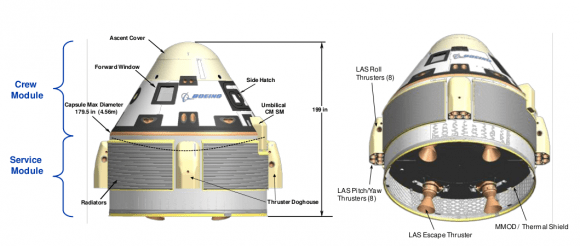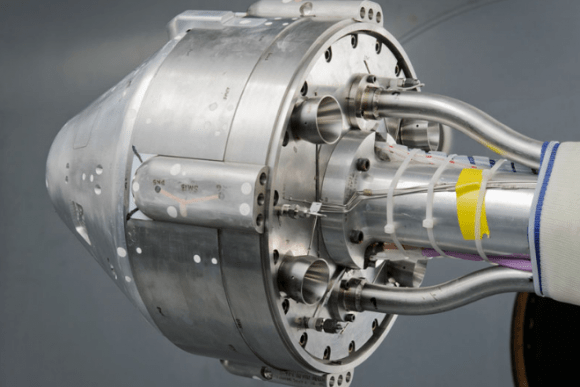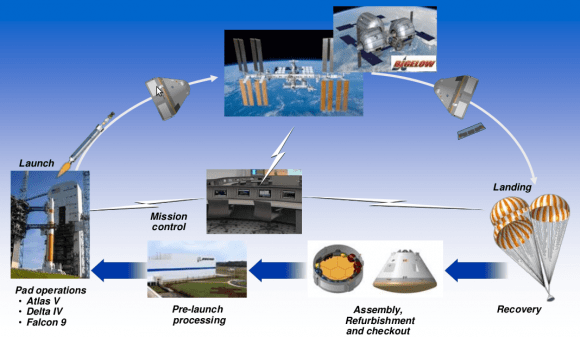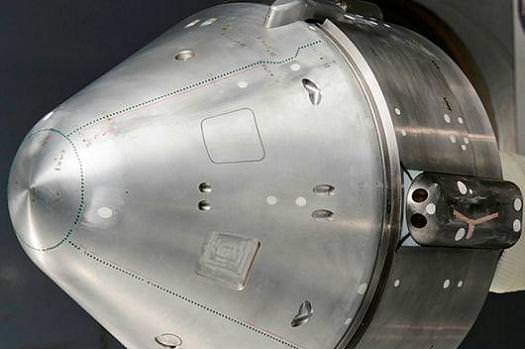[/caption]
Boeing recently began wind tunnel testing on its CST-100 (Crew Space Transport) capsule, designed to service destinations in Low Earth Orbit (LEO), locations like the ISS and Bigelow Space Stations. These tests have been on going since Sept. 17th of this year, collecting data on “20 different positions to mimic the different phases of an aborted landing”, Boeing said in a press release. These tests may lead to extensive changes and are critical to the craft’s safety.
The tests will move onto analyze ”approaches to abort before liftoff, abort after separation from the rocket, abort in orbit, etc” said Paula Korn, media contact for space exploration at Boeing, in an email to Universe Today. All these abort modes place high aerodynamic stress on the capsule and each abort mode has it own stresses. Each of the modes must be balanced for an ideal space system.
“Each of these approaches involves various aspects of problem solving and design solutions and are based on lessons learned from our 50 years of human spaceflight, starting with the early Mercury missions,” Korn said. “We are also integrating innovative, new design aspects to optimize safety, reliability and affordability objectives”.


The test platform was a 1/14th scale representation of the crew module and service module – the cone that houses the crew connected the uninhabited cylinder that houses the engines and other support systems. Jutting out of the model of the service module there are four thruster doghouses in addition to one umbilical cover for the crew and service modules. Poking out of the back of the model are four LAS (Launch Abort System) thrusters.
This extensive detail in the model combined with “hundreds of pinhole-sized sensors” give Boeing engineers precise views of the aerodynamics of the CST-100. “As engineers, we like data and numbers, and you can take all of this and make something meaningful out of it,” said Boeing engineer Dustin Choe. “We can reduce it down and provide a clearer picture of what we will experience in flight.” Based on this data there will be further changes to the spacecraft.

There are more tests in store for Boeing’s answer to NASA’s Commercial Crew Development program. Boeing and Bigelow have already “dropped a mock capsule off a moving truck,” Boeing said in the press release, “to test the external airbags the real spacecraft would deploy to cushion a landing on Earth.”. “In the first quarter 2012,” Korn confirmed that “we are planning to perform parachute drop tests”.


I may believe Dragon is the better vehicle, but it is still nice to see more than one spacecraft getting development time. The more we have, the more we’ll send up and the more we’ll need/want to send up. 😉
Agreed.
Btw, it looks like an inferior and rushed (nothing inventive) rip-off of Dragon solutions on an Apollo design. I’m sure SpaceX thinks of it as a “mock” capsule. =D
Well, if it works it is all good. Except they are likely too late compared to all the contenders to capture any sound market share.
[Added in posting: Ha, it seems Boeing agrees with my analysis:
“As of July 2010, Boeing stated that the capsule could be operational in 2015 with sufficient near-term approvals and funding, but also indicated they would proceed with development of the CST-100 only if NASA implemented the commercial crew transport initiative that was announced by the Obama administration in its FY11 budget request. Boeing executive Roger Krone stated that NASA investment would allow Boeing to close the business case, while this would be very difficult without NASA. In addition a second destination besides the ISS would be needed to close the business case and Krone said that cooperation with Bigelow was crucial for this.[4]”]
Competition is good.
60’s tech,.,.
And yet today’s automobiles also have four wheels and a steering wheel, as they did about 100 years ago. Does that make them the same?
Just because it’s a ballistic capsule doesn’t mean it’s your father’s capsule…
I agree with yahoo-ZFUOW2RVXMXP6I7QUKGFJK4KFQ, it IS 60’s tech… but proven to work… Of course it would be far cooler if we had a single stage to orbit, winged shuttle instead!